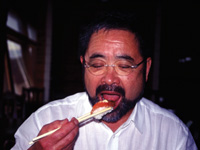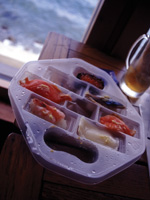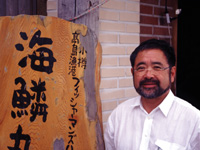Frozen Fish That Tastes Fresh -- Really!
Back to Contents of Issue: December 2003
|
|
|
|
by David Wolman |
|
|
The company is Kairinmaru Beer Ltd., founded by Otaru native Hajime Sawatari, 63, who got interested in the sushi business partly because seven competing microbreweries in the same town were a few too many, and also because Otaru, as one of Japan's most renowned sushi ports, was a perfect place to launch an innovative seafood operation.
We're sitting in Sawatari's seaside restaurant, the Fisherman's Harbor, sampling sushi and discussing the icy science behind the company's patented freezing process, or at least the part that's not top secret. (The restaurant itself serves only fresh fish, but the company's chilly factory next door is less suitable for interviews and taste tests.)
"People think freezing reduces quality, but if the science is sophisticated enough, that's not true at all," says Sawatari. "With our technology, you can freeze and send food -- good food like Otaru sushi -- all over the world."
On the back of a paper chopsticks package, Sawatari sketches tiny spheres representing the cells of fish meat together with little globs of water wedged between them. (Educated neither in sushi nor science, Sawatari is an artist by training, which explains his propensity for sketching pictures.) As we all learned at one time or another, water expands when frozen. Tiny ice crystals inside a piece of mackerel, tobiko or any other tender fish can damage surrounding cells, hurting texture and flavor.
But Kairinmaru's technicians have come up with a method for removing many of those potentially damaging water molecules with minimal impact on taste, while also using natural additives to reinforce the walls of the fish's natural cells. What those additives are Sawatari won't say, but he emphasizes that the process is all natural.
The trick is speed. By freezing the sushi extremely fast, there's no time for the water and starch to separate. Again, Sawatari is careful not to reveal any secrets, but he does say that the technology is based on electricity and can freeze sushi five times faster than the blast chilling method used on fishing trawlers, and 20 times faster than standard food industry processes. "If we use our technology to freeze a fly or a goldfish, it will still be alive when it's defrosted."
During all this techno-talk, I'm sampling the goods. The company offers a few different packages of sushi with combinations of the conventional varieties -- salmon, tuna, salmon roe, bonito, sea urchin, shrimp, squid, scallop, amberjack, et cetera -- as well as different vegetable roll options like pumpkin and kidney bean tempura. To cast a wider clientele net, Kairinmaru's sushi isn't made with wasabi, but the spicy green mustard comes in a separate package for those who prefer their sushi with the traditional kick.
The company's rice is noticeably sweeter than normal, which may be a side-effect of the secret additives or an intentional gambit to court foreign customers with sweeter palates, or a combination of both. Two Japanese taste-testers at our table are generally impressed with the quality and taste of the sushi, but say later that the rice was so sweet they craved some green tea afterwards, "to balance out the flavor."
Ordinary sushi prepared for supermarket customers will start getting fishy after five or six hours sitting around. Not so if it's frozen. What's more, Kairinmaru sushi apparently has a much longer lifespan once defrosted, lasting up to 48 hours if kept in a cool-air environment. (Although, why bother letting it sit around if you can defrost it just before eating?)
After only three years, Kairinmaru's frozen sushi business is booming, perhaps even more so than Sawatari first anticipated, especially in the massive US market. In addition to the Otaru factory, the company now has two facilities in China preparing its meals, and Sawatari is currently courting business partners in Europe. Financials for 2003 aren't in yet, but last year the company recorded $5.3 million in sales while employing almost 70 people. Profit for 2002 was minimal, but that may be the result of Kairinmaru's enormous investment in expansion.
Last year, Kairinmaru also sold the rights to its preservation and freezing process to Maruha, a giant Japanese marine products company. At a Maruha factory in Salem, Oregon, 900,000 frozen sushi meals are produced every month. The company is currently in negotiations with retailers like Kroger, Wal-Mart and Circle-K.
What's next? The Otaru factory recently began producing frozen soba, or buckwheat noodles, another food about which the Japanese are famously discriminating. "Some of our best customers for the noodles are restaurants that advertise 'handmade soba'," says Sawatari incredulously. If soba is doable, why not try freezing the varieties of noodles used in ramen? "We're working on it." @ |
|
Note: The function "email this page" is currently not supported for this page.


 SUSHI FROM THE FREEZER? The concept alone is such a recipe for double-takes and skepticism that employees at a burgeoning Hokkaido-based firm have the very query, "Frozen Sushi?" printed on their business cards. Yet there it is, sitting in front of me on the table in plastic, hexagonal packages, just defrosted after weeks in the freezer. And get this: It's pretty good.
SUSHI FROM THE FREEZER? The concept alone is such a recipe for double-takes and skepticism that employees at a burgeoning Hokkaido-based firm have the very query, "Frozen Sushi?" printed on their business cards. Yet there it is, sitting in front of me on the table in plastic, hexagonal packages, just defrosted after weeks in the freezer. And get this: It's pretty good.
 What about the rice? If you've ever tried to freeze leftover white rice then thawed it out for another meal, you may know that doing so causes it to lose not only its color but also its sticky texture, which is paramount to catastrophe for good sushi. Time for a bit more science. When rice freezes, its starch and water content separate. "But we've found a way to make the water content and starch content bond together more firmly," says Sawatari, as if describing the latest gizmo from Silicon Valley.
What about the rice? If you've ever tried to freeze leftover white rice then thawed it out for another meal, you may know that doing so causes it to lose not only its color but also its sticky texture, which is paramount to catastrophe for good sushi. Time for a bit more science. When rice freezes, its starch and water content separate. "But we've found a way to make the water content and starch content bond together more firmly," says Sawatari, as if describing the latest gizmo from Silicon Valley.
 In sushi restaurants or bars, a major influence on taste is seeing an expert chef prepare the delicacies in front of your eyes. Store-bought products can't compete with that kind of freshness and dining experience, and Sawatari doesn't plan to: His target is exclusively supermarket shoppers. "The store-bought sushi in England, for example, is so bad you just can't believe it. People tell me foreigners have such an untrained sense for sushi that quality doesn't matter; anything will sell. I don't agree. I think anything labeled with the word 'sushi' should be high quality and live up to the standard of Japanese consumers."
In sushi restaurants or bars, a major influence on taste is seeing an expert chef prepare the delicacies in front of your eyes. Store-bought products can't compete with that kind of freshness and dining experience, and Sawatari doesn't plan to: His target is exclusively supermarket shoppers. "The store-bought sushi in England, for example, is so bad you just can't believe it. People tell me foreigners have such an untrained sense for sushi that quality doesn't matter; anything will sell. I don't agree. I think anything labeled with the word 'sushi' should be high quality and live up to the standard of Japanese consumers."



